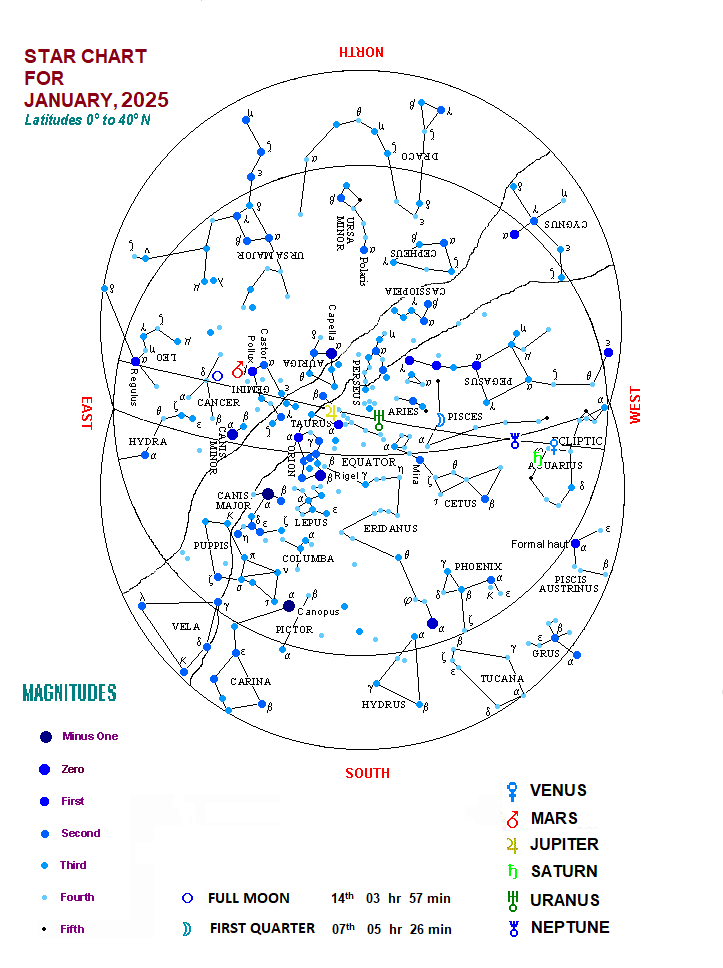Sky Chart For The Month of January, 2025

ASTRONOMICAL BULLETIN FOR JANUARY 2025
The Moon
|
First Quarter occurs on 07th at h. 05-26 I.S.T. |
Full Moon occurs on 14th at h 03-57 I.S.T. |
|
Last Quarter occurs on 22th at h 02-01 I.S.T. |
New Moon occurs on 29th at h 18-06 I.S.T. |
|
|
|
|
The Lunar Crescent becomes first visible after the New Moon day in the evening of 30th. |
|
|
The Moon is at Perigee or nearest to the Earth on 8th and at Apogee or farthest from the Earth on 21st. |
|
The Moon passes about 1½º south of Venus on 3rd, about ½º north of Saturn on 4th, about 1º north of Neptune on 5th before midnight, about 4½º north of Uranus on 9th before midnight, about 5½º north of Jupiter on 11th, about ½º north of Mars on 14th, about 2½º south of Mercury on 29th.
The Earth
The Earth approaches the perihelion position on its orbit or reaches nearest to the Sun on 4th.
The Planets
Visibility of Planets:
Mercury: The planet rises about 1½ hours to 1 hour before sunrise upto second quarter the month, about 1 hour to ½ hour before it upto 19th of the month. From 20th planet is too close to the Sun to be visible. The planet is at aphelion or farthest from the Sun in its orbit on 19th.
Venus: The planet sets about 3½ hours after sunset throughout the month. It is in Greatest Eastern Elongation of about 47.2º from the Sun on 10th.
Mars: The planet rises about 1½ hours to 1 hour after sunset upto first quarter of the month, thereafter the planet rises close to sunset time upto second quarter of the month and sets close to sunrise time upto third quarter of the month, thereafter planet sets close to sunrise time to about 1 hour before sunrise for the remaining days of the month. The planet is in Opposition with the sun on 16th.
Jupiter: The planet sets about 2 hours to 2½ hours before sunrise upto first quarter of the month, about 2½ hours to 3 hours before it upto second quarter of the month, about 3 hours to 3½ hours before it upto third quarter of the month and about 3½ hours to 4 hours before it for the remaining days of the month.
Saturn: The planet sets about 2 hours to 2½ hours before local midnight upto first quarter of the month, about 2½ hours to 3 hours before it upto second quarter of the month, about 3 hours to 3½ hours before it upto third Quarter of the month, about 3½ hours to 4 hours before it for the remaining days of the month.
Uranus: The planet sets about 3 hours to 2½ hours after local midnight upto first quarter of month, about 2½ hours to 2 hours after it upto second quarter of the month, about 2 hours to 1½ hours after it third quarter of month and about 1½ hours to 1 hour after it for the remaining days of the month. The motion of the planet becomes Direct with respect to Earth from 30th.
Neptune: The planet sets about 1½ hours to 2 hours before local midnight upto first quarter of the month, about 2 hours to 2½ hours before it upto third quarter of the month and about 2½ hours to 3 hours before it for the remaining days of the month.
Conjunction of Planet:
Venus passes about 2½º north of Saturn on 20th.
Mars passes about 2½º south of Pollux(Punarvasu) on 21st.
|
Planets |
Planets in Zodiacal Constellation |
Magnitude |
|
Mercury (Budha) |
Moves from Scorpion (Vrischika) to Sagittarius (Dhanus) on 04th. Moves from Sagittarius(Dhanus) to Capricornus (Makara) on 24th. |
– 0.4 to + 0.0 +0.0 to – 0.9 |
|
Venus (Sukra) |
Moves from Aquarius (Kumbha) to Pisces (Mina) on 28th. |
– 4.5 to – 4.8 |
|
Mars (Mangala) |
Moves from Cancer(Karkata) to Gemini (Mithuna) on 21st. (Retrograde) |
– 1.2 to + 0.0 +0.0 to – 1.1 |
|
Jupiter (Brihaspati) |
Remains in Taurus (Vrisha). |
– 2.7 to – 2.6 |
|
Saturn (Sani) |
Remains in Aquarius (Kumbha). |
+ 1.1 |
|
Uranus |
Remains in Aries (Mesha). |
+ 6.0 |
|
Neptune |
Remains in Pisces (Mina). |
+ 8.0 |
Source : : Director
Positional Astronomy Centre
India Meteorological Department
Salt Lake, Kolkata - 700 091.